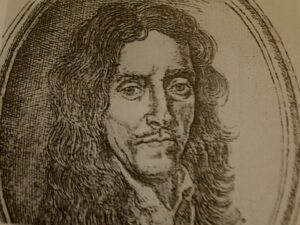The heyday of the battuto-pizzicato repertoire was in the second half of the 17th century. The guitar’s greatest success was mainly due to a few charismatic virtuosi such as Francesco Corbetta, who was a welcome guest at the courts of Europe.
However, some of the most important innovations in terms of the style can be found in Bartolotti’s Secondo libro (c. 1655). Angelo Michele (or Michelangelo) Bartolotti was famous mainly as a player of the theorbo, rather than as a performer of guitar music. In his second guitar book we find works in the pizzicato style of the lute, next to dances like the sarabanda and the passacaglia, which are predominantly strummed. Bartolotti’s virtuosic use of the guitar is striking, as is his successful integration of the Italian and French styles.
Vincenzo Albrici (1631 – 1687)
- Sinfonia in D minor
Musica Antiqua Köln

Portrait of Bartolotti, from his Secondo libro.
(cd Musica Baltica, DG Archiv 459 619-2AH, 1999)
Michelangelo Bartolotti (fl. 1640 – 1669)
Suite in E minor
- Prelude
- Allemande
- Courante
- Sarabande
- Gigue
- Passacaille
Lex Eisenhardt, baroque guitar
(personal archive)
Giovanni Antonio Pandolfi Mealli (1624 – c. 1687)
- La Vinciolina
Andrew Manze, violin and Fred Jacobs, theorbo
(cd Pandolfi Mealli violin sonatas, Channel Classics, CCS 5894, 1992)
Michelangelo Bartolotti
- Prelude
- Allemande
Simon Linné, theorbo
(cd l’Art du théorbiste, Brilliant Classics 95426, 2017)
Johann Jacob Froberger (1616 – 1667)
Suite in D minor
- Allemande
- Courante
- Sarabande
- Gigue
Gilbert Rowland, harpsichord
(cd Froberger: Suites for harpsichord, Athene Records ATH 23204, 2019)
Michelangelo Bartolotti
- Sarabande
- Gigue
- Chaconne
Simon Linné, theorbo
(cd l’Art du théorbiste, Brilliant Classics 95426, 2017)








